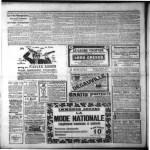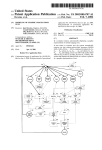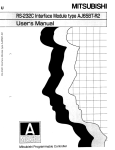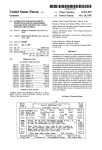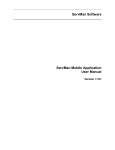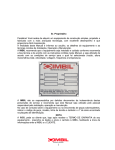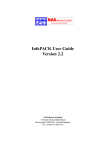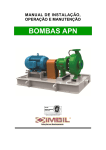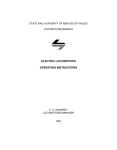Download APLIHDIS
Transcript
United States Patent [191 [11] [451 Chang et a1. [54] SYSTEM AND METHOD FOR USING CACI'IED DATA AT A LOCAL NODE AFI'ER RE-OPENING A FILE AT A REMOTE NODE IN A DISTRIBUTED NETWORKING [75] Inventors: Albert Chang; Grover H. Neuman; ronment", pp. 28-36. Hamilton, Richard et al., “An Administrator’s View of Remote File Sharing”, pp. 1-9. Houghton, Tom et al., “File Systems Switch", pp. l-2. Olander, David J. et al., “A Framework for Network Corporation, Armonk, NY. ing in System V”, pp. 1-8. Primary Examiner-Thomas C. Lee Attorney, Agent, or Firm—-Marilyn D. Smith [57] ABSTRACT 364/284.4; 364/285.4; 364/264; 364/300 [531 Field of Search 364/200 MS File, 900 MS File, 364/ 300 References Cited U.S. PATENT DOCUMENTS 4,432,057 2/ 1984 4,620,276 10/ 1986 l/l987 11/1987 Ng ................ .. 12/1987 Blacknell et al. 12/1987 Gladney et a1. 4,714,995 12/1987 l/1988 1/1988 distributed services program installed on the systems in the network allows the processors to access data ?les distributed across the various nodes of the network without regard to the location 01‘ the data tile in the network. The processing system accessing ?le, referred to as the client processing system, utilizes a client cache within its operating system to store the data ?le. Utiliz ing the client cache minimizes the number of reads and .. Matema et a1. . . . . 4,714,996 12/1987 Gladney et a1. 4,718,002 4,718,005 In a distributed environment several data processing systems are interconnected across a network system. A Daniell et a1. .................... .. 364/200 . 4,635,189 4,686,620 4,710,870 4,714,992 364/200 writes that must go over the network to the server . . . .. 364/200 364/300 processing system where the ?le physically resides. The Carr .......................... .. 364/200 Feigenbaum et a1. ............ .. 364/200 system and method of this invention prevents a process in the client processing system from accessing data in the client cache that has been modi?ed at another node in the network. The blocks of data in the client cache OTHER PUBLICATIONS Baird, “Sharing of Disk Files Without Locking", IBM TDB vol. 22, No. 7, Dec. 1979, pp. 2887-2889. Serutchin et al., “Multi-Access Data Sharing Facility are tested for validity in the client processing system by using modi?cation times as measured by the server processing system. If the cache data blocks are deter Utilizing Magnetic Bubble Storage”, IBM, TDB, vol. mined to be valid, the data blocks are determined to be invalid, the data blocks are discarded, and the ?le is accessed from the server processing system. 23, No. 8, Jan., 1981, pp. 3882-3885. Rifkin et al., “RFS Architectural Overview”, pp. l-12. Kleiman, S. R., “Vnodes: An Architecture for Multiple File System Types in Sun UNIX”, pp. 238-247. 16 Claims, 11 Drawing Sheets ll; APLIE HS Jan. 30, 1990 Chang, .loMei, "SunNet”, pp. 71-75. Taylor, Bradley, “Secure Networking in the Sun Envi Amal A. Slinheen-Gouda; Todd A. Smith, all of Austin, Tex. International Business Machines [21] Appl. No.: 14,899 Feb. 13, 1987 [22] Filed: [5 1] Int. Cl.‘ ..................... .. G06F 15/16; G06F 11/00 [52] US. Cl. ............................. .. 364/200; 364/222.8l; [56] 4,897,781 Sandberg, R. et al., “Design and Implementation of the Sun Network Filesystem", pp. 119-130. Walsh, Dan et al., “Overview of the Sun Network File System”, pp. 117-124. Chang, JoMei, “Status Monitor Provides Network Locking Service for NFS”, pp. 1-3. ENVIRONMENT [73] Assignee: Patent Number: Date of Patent: APLIHDS FIOCtSl IACPHIO.S PROCES l PROCKSE ' US. Patent Jan. 30, 1990 Sheet 1 of 11 APPLICATION 4,897,781 M N1 0. s. 1_1_A_ 5“ 1% 2A H NETWORK APPLICATION Q A x APPLTCATION C B o. s 4_4_c L29 PRTOR ART FIG. 1 Q US. Patent Jan. 30, 1990 Sheet 2 0f 11 APPLICATION READ (F | LE DESCR IPTUR , N4 1 | PROCESSES 43 /1/~ USER ADDRESS SPACE VR H LBIH m PRIOR AR T F lG . 4,897,781 US. Patent Sheet 3 of 11 Jan. 30, 1990 READ (FILE DESCRIPTOR , BYTE RANGE ) CONVERT TD 1 READ (DEVICE NUMBER, LDG ICAL BLOCK NUMBERS IN DEVICE ) 60 T0 CORRESPONDING BLOCK IN CACHE PRIDR ART FIG. 3 4 N402 M403 4,897,781 US. Patent Jan. 30, 1990 Sheet 4 0f 11 APPLICATIONS 4A PROCESSES 0.5. 4,897,781 45_,\ A 5 —- H-l-H- »42A A FIG. 4 NETWORK .3. APPLICATIONS PROCESSES 4B 4i 40B __ 0.5. B APPLICATIONS 4i PROCESSES 43_@ lo_c c 0.5. “c 448 —— FFFFF; — ( 420 42B G28 zc/i US. Patent Jan. 30, 1990 Sheet 5 of 11 seam nova A 4,897,781 m | an 1 “one B APPL 1cm 1 0 us 55 APPLI on | o u s‘ PROCESSES 431T432T453T43N : _ Q P‘ROCESSES 2311-232 TzssTzan _T_ ussn mnsss space ussn mnsss SPACE ' m moo: mm -T_ : LLB H‘ E Eh“, # 1 ‘~’ e---— Gil: SERVER CACHE cum CACHE ommmc ‘L6 L21 "'m svsma M “A READ (ms DESCRIPTOR, 54 1/" READDNLY n4) 5° 5° ns us A ' m5 # or '\ a s2 # or was WRITES 2 54 _/ ASYNCH /' 50 FlG. 5 54)‘ 53.) "\ #- or r mos res‘ 2 s i a 5 - l ms s2 # or 0 1 —\ 52 \ 54 WRITES 0 \ 54) 1L US, Patent Jan. 30, 1990 4,897,781 Sheet 6 of 11 FILE om FOR wa ITE BY PROCESSES LOCATED IN nus REMOTE none ' /l/ 4 4 44 4; FILE om m non: mu ONE MODE FILE OPEN FOR READ ONLY ACCESS “5 L“ AT LEAST one NODE ms FILE 4 7 /z/ om FOR WRITE ACCESS F l G. FILE OPEN ron H 1 TE l n A PROCESS IN THE SERVER 6 US. Patent Jan. 30, 1990 Sheet 7 of 11 4,897,781 g N TA .-0_. _. 3g2:- :2h.£233: x.:wi m SEE5.3o QQN 32;:0 3:.“2:5831 :2333SIo: 32.3 3:; no US. Patent Jan. 30, 1990 Sheet 8 of 11 4,897,781 I) L l ENT NUDE B SERVER NUDE A 0 RN .lrv A_ R S RILC TN RcRTLAECAI.rL. cSH HAs EFLFIP AsA05B PDPPNV1IDAES1PI|. S5N AL 5 CsAonB Anss05 FsC2 w5. A“A58 Lso SENI cN \\AlhP EAI I.2S.N E2 MED 2_sS AF. \EnlD(r.A\1 P m / 4 F.\J0 OSD1D3001 B4 V5nm/I341 ~A5 f o F F 4I Ah ? 5 30 L UN s5 l\./ cA 4 FIG. I If! 4)l1\‘|/ 2 :15) 1.. US. Patent Jan. 30, 1990 Sheet 9 of 11 4,897,781 READ (FILE DESCR|PT0R.m,1/-4Q4 LOOK IN CL IENT CACHE ,A/ 405 READ FROM DATA HI CLIENT CACHE CLIENT CACHE i SEND TO SERVER -/1/- 1 O8 CONVERT TO DEVICE # , LOGICAL BLOCK # d/l/ma LOOK IN SERVER CACHE .rv‘ HO FIG. 9 US. Patent Jan. 30, 1990 Sheet 10 of 11 4,897,781 FIG. ‘l0 Tl. w o2 J] DPIVHI ESP —.. “CL wA R3Po m" AllP AT s4I 3 H 3 2Ss M / A “I1 84 N BB1|II5 2_ .1N4I‘4l1 205A MRTL 0E L c‘\I' 0RTL LH9..nu n m u5|PM aK UCu".HT ML m n. EsA2. EE ASI"2Im _l0..0 _ 2I1| E IIALA.3I SFA n A w M H s 3 B E3 sD NT."M TIT.II.El (.13 4a06 HI P2 v A “a P..T.. :J a_ z ~ 4lln4 45 5I12 B7EL 9.. 5 c HS US. Patent Jan. 30, 1990 OPEN FILE AT CLIENT Sheet 11 0f 11 A'I2O 4,897,781 I DISCARD FILE ACCESS LCREATE SURROCATE moo?MIzI WRITE TIME FROM SERVER TO S-INODE UPDATE FILE ACCESS STRUCTURE UPDATE FILE ACCESS 1, I32 CLOSE ACK FRON SER vER m CLIENT “1,433 UPDATE TIME IN CACHE BLQQKS RELEASE 5 "409E 1'2 11434 "L- I22 ‘V423 ISSUE READ ASSICN CACHE om mom RE CORD TIME IN BLOCK STRUCTURE - FILE n @435 “1/424 STRUCTURE ‘V425 2ND OPEN AT CLIENT /1/ 426 2ND READ ASSICN CACHE DATA BLOCK RECORD TIME IN BLOCK -?/12T CREATE S-IIIOOE IIRITE TIRE FROM SERVER 15 _ ‘1/436 DISCARD CLIENT CACHE READ FROIA SERVER z43B UPDATE FILE ACCESS STRUCTURE ."1/ 428 READ FRON CLIENT UPDATE FILE ACCESS STRUCTURE ‘V 430 FIG. 44 LAST CLOSE AT CLIENT "VIM 4,897,781 1 2 NETWORKING ENVIRONMENT The problems encountered in accessing a ?le at a remote nodes can be better understood by ?rst examin ing how a stand-alone system accesses ?les. In a standa lone system, such as 10 as shown in FIG. 2, a local buffer 12 in the operating system 11 is used to buffer the CROSS REFERENCE TO RELATED as a hard ?le or a disk in a personal computer, and the SYSTEM AND METHOD FOR USING CACHED DATA AT A LOCAL NODE AFTER RE-OPENING A FILE AT A REMOTE NODE IN A DISTRIBUTED data transferred between the permanent storage 2, such APPLICATIONS user address space 14. The local buffer 12 in the operat ing system 11 is also referred to as a local cache or This application is related in subject matter to the kernel buffer. In the standalone system, the kernel buffer 12 is iden following applications ?led concurrently herewith and assigned to a common assignee: ApplicatIon Ser. No. 07/014,884, currently copend ti?ed by blocks 15 which are designated as device num~ ing and ?led by D. W. Johnson, L. W. Henson, A. A. Shaheen-Gouda, and T. A. Smith for Negotiating Com her, and logical block number within the device. When by D. W. Johnson, G. H. Neuman, C. H. Sauer, A. A. Shaheen-Gouda, and T. A. Smith for A System And Method For Accessing Remote Files In A Distributed and logical block'numbers in the device, step 102, FIG. 3. Then the operating system 11 reads the cache 12 according to the device number and logical block num Networking Environment. Application Ser. No. 07/014, currently copending bers, step 103. Any data read from the disk 2 is kept in the cache a read system call 16 is issued, it is issued with a ?le munication Conventions Between Nodes In A Net 15 descriptor of the ?le 5, and a byte range within the ?le 5, as shown in step 101, FIG. 3. The operating system 11 work, now abandoned. takes this information and converts it to device number, Ser. No. 07/014,897, currently copending and ?led block 15 until the cache block 15 is needed. Conse quently, any successive read requests from an applica Application Ser. No. 07/014,891, curently copending 25 tion 4 that is running on the processing system 10 for the same data previously read is accessed from the cache l2 and ?led by L. W. Henson, A. A. Shaheen-Gouda, and and not the disk 2. Reading from the cache is less time T. A. Smith for File and Record Locking Between and ?led by D. W. Johnson, A. A. Shaheen-Gouda, T. A. Smith for Distributed File Access Structure Lock. consuming than going out to the fixed disk 2, accessing Nodes in A Distributed Data Processing Environment. the correct disk sectors, and reading from the disk. 30 Similarly, data written from the application 4 is not ing and ?led by D. W. Johnson, L. K. Loucks, C. H. saved immediately on the disk 2, but is written to the Sauer, and T. A. Smith for Single System Image cache 12. This saves disk accesses if another write oper Uniquely De?ning An Environment For Use In A Data Application Ser. No. 07/014,892, currently copend Processing System. Application Ser. No. 07/014,888, currently copend ing and ?led by D. W. Johnson, L. K. Loucks, A. A. Shaheen-Gouda for Intel-process 35 Communication Queue Location Transparency. Application Ser. No. 07/014,889, currently copend reading the blocks. ing and ?led by D. W. Johnson, A. A. Shaheen-Gouda, tions are incorporated herein by reference. DESCRIPTION Another use of the local cache in a stand-alone sys tem is to hold valid data for a ?le even after the ?le is closed. If the tile is re-opened while these blocks still exist in the cache, then no disk access is required for Use of a cache in a standalone system that utilizes an and T. A. Smith for Directory Cache Management In a Distributed Data Processing System. The disclosures of the foregoing co-pending applica ation is issued to the same block. Modi?ed data blocks in the cache 12 are saved on the disk 2 periodically. AIX1 (Advanced Interactive Executive) operating sys tem improves the overall performance of the system since disk accessing is eliminated for successive reads and writes. Overall performance is enhanced because 4-5 accessing permanent storage is slower and more expen 1. Field of the Invention This invention relates to processing systems con nected through a network, and more particularly to the sive than accessin a cache. lAIX is a trademark 0 IBM Corporation. In a distributed environment, as shown in FIG. 1, there are two ways the processing system 10C in local accessing of ?les between local and remote processing 50 node C could read the ?le 5A from node A. In one way, systems in a distributed networking environment. the processing system 10C could copy the whole ?le 2. Background Art 5A, and then read it as if it were a local ?le 5C residing at node C. Reading a ?le in this way creates a problem ronment 1 consists of two or more nodes A, B, C, con if another processing system 103, 10A at another node nected through a communication link or a network 3. 55 A, B modi?es the ?le 5A after the ?le SA has been The network 3 can be either a local area network copied at node C. The processing system 10C would not (LAN), or a wide area network (WAN). The latter have access to these latest modi?cations to the ?le 5A. consists of switched or leased teleprocessing (TP) con Another way for processing system 10C to access a nections to other nodes, or to a systems network archi ?le 5A at node A is to read one block N1 at a time as the As shown in FIG. 1, a distributed networking envi tecture (SNA) network of systems. At any of the nodes A, B, C, there may be a process ing system 10A, 10B, 10C, such as a personal computer. Each of these processing systems 10A, 10B, 10C, may processing system at node C requires it. A problem with this method is that every read has to go across the net work communication link 3 to the node A where the ?le resides. Sending the data for every successive read is be a single user system or a multi-user system with the ability to use the network 3 to access ?les located at a 65 time consuming. remote node. For example, the processing system 10A peting problems as illustrated above. One problem in at local node A, is able to access the ?les 5B, 5C at the remote nodes B, C. Accessing ?les across a network presents two com volves the time required to transmit data across the network for successive reads and writes. On the other 3 4,897,781 hand, if the ?le data is stored in the node to reduce network traffic, the ?le integrity may be lost. For exam ple, if one of the several nodes is also writing to the ?le, the other nodes accessing the ?le may not be accessing the latest updated ?le that has just been written. As such, the ?le integrity is lost since a node may be access ing incorrect and outdated ?les. Within this document, the term “server" will be used to indicate the node where the ?le is permanently stored, and the term “client” will be used to mean any other node having processes accessing the ?le. It is to be understood, however, that the term "server” does not mean a dedicated server as that term is used in some local area network systems. The distributed services system in which the invention is implemented is a truly distributed system supporting a wide variety of applica tions running at different nodes in the system which may access ?les located anywhere in the system. The invention to be described hereinafter was imple mented in a version of the UNIX2 operating system but may be used in other operating systems having charac teristics similar to the UNIX operating system. The UNIX operating system was developed by Bell Tele phone Laboratories, Inc., for use on a Digital Equip ment Corporation (DEC) minicomputer but has be come a popular operating system for a wide range of minicomputers and, more recently, microcomputers. One reason for this popularity is that the UNIX operat ing system is written in the C programming language, also developed at Bell Telephone Laboratories, rather than in assembly language so that it is not processor speci?c. Thus, compilers written for various machines to give them C capability make it possible to transport the UNIX operating system from one machine to an other. Therefore, application programs written for the UNIX operating system environment are also portable from one machine to another. For more information on the UNIX operating system, the reader is referred to UNIX TM System, User’s Manual, System V, published by Western Electric Co., January 1983. A good over view of the UNIX operating system is provided by Brian W. Kernighan and Rob Pike in their book entitled The Unix Programming Environment, published by 3RT and RT PC are trademarks of IBM Corporation. The invention is speci?cally concerned with distrib uted data processing systems characterized by a plural ity of processors interconnected in a network. As actu ally implemented, the invention runs on a plurality of IBM RT PCs interconnected by IBM’s Systems Net work Architecture (SNA), and more speci?cally SNA LU 6.2 Advanced Program to Program Communica tion (APPC). An Introduction To Advanced Program-To Program Communication (APPC). Technical Bulletin by IBM International Systems Centers, July 1983, no. GG24-l584'0, and IBM RT PC SNA Access Method Guide and Reference. Aug. 15, 1986, are two documents that further describe SNA LU 6.2. SNA uses as its link level Ethernet‘ a local area net‘ work (LAN) developed by Xerox Corp., or SDLC (Synchronous Data Link Control). A simpli?ed de scription of local area networks including the Ethernet local area network may be found in a book by Larry E. Jordan and Bruce Churchill entitled Communications and Networking for the IBM PC, published by Robert J. Brady (a Prentice-Hall company) (1983). A more de?ni ti ve description of communications systems for comput ers, particularly of SNA and SDLC, is to be found in a book by R. J. Cypser entitled Communications Architec turefbr Distributed Systems, published by Addison-Wes ley (1978). It will, however, be understood that the invention may be implemented using other and different computers than the IBM RT PC interconnected by other networks than the Ethernet local area network or IBM’s SNA. "Ethernet is a trademark of Xerox Corporation. As mentioned, the invention to be described hereinaf~ ter is directed to a distributed data processing system in a communication network. In this environment, each processor at‘a node in the network potentially may access all the ?les in the network no matter at which nodes the ?les may reside. Other approaches to supporting a distributed data processing system in a UNIX operating system environ ment are known. For example, Sun Microsystems has released a Network File System (NFS) and Bell Labo ratories has developed a Remote File System (RFS). The Sun Microsystems NFS has been described in a Prentice-Hall (1984). A more detailed description of the series of publications including S.R. Kleiman, “Vnodes: design of the UNIX operating system is to be found in 45 An Architecture for Multiple File System Types in Sun a book by Maurice J. Bach, Design of the Unix Operating UNIX", Conference Proceedings, USENIX 1986 Summer Sgitem, published b Prentice-Hall (1986). - 2 veloped and licensed y AT&T. UNIX is a registered trademark of AT&T in the U.S.A. and other countries. AT&T Bell Labs has licensed a number of parties to use the UNIX operating system, and there are now several versions available. The most current version from AT&T is version 5.2. Another version known as Technical Conference and Exhibition, pp. 238 to 247; the Sun Network Filesystem”, Conference Proceedings, Use nix 1985, pp. 119 to 130; Dan Walsh et al., “Overview of the Sun Network File System”, pp. 117 to 124; JoMei the Berkeley version of the UNIX operating system was Chang, “Status Monitor Provides Network Locking Service for NFS"; JoMei Chang, “SunNet”, pp. 71 to 75; and Bradley Taylor, “Secure Networking in the Sun developed by the University of California at Berkeley. Microsoft, the publisher of the popular MS-DOS and PC-DOS operating systems for personal computers, has Environment”, pp. 28 to 36. The AT&T RFS has also been described in a series of publications including An drew P. Rifkin et al., "RFS Architectural Overview”, a version known under their trademark as XENIX. USENIX Conference Proceedings, Atlanta, Georgia With the announcement of the IBM RT PC3 (RISC (June 1986), pp. 1 to 12; Richard Hamilton et al., “An (reduced instruction set computer) Technology Per Administrator's View of Remote File Sharing”, pp. 1 to sonal Computer» in 1985, IBM Corp. released a new 9; Tom Houghton et al., “File Systems Switch", pp. 1 to operating system called AIX which is compatible at the 2; and David J. Olander et al., "A Framework for Net application interface level with AT&T’s UNIX operat working in System V”, pp. 1 to 8. ing system, version 5.2, and includes extensions to the One feature of the distributed services system in UNIX operating system, version 5.2. For more descrip 65 which the subject invention is implemented which dis tion of the AIX operating system, the reader is referred tinguishes it from the Sun Microsystems NFS, for exam to AIX Operating System Technical Reference, published ple, is that Sun’s approach was to design what is essen by IBM Corp, First Edition (Nov. 1985). tially a stateless machine. More speci?cally, the server 5 4,897,781 in a distributed system may be designed to be stateless. This means that the server does not store any informa tion about client nodes, including such information as 6 To determine whether or not the data in the client cache has been modi?ed at another node while the ?le was closed at the client node, the system of this inven which client nodes have a server ?le open, whether tion comprises a surrogate inode in the client cache. client processes have a ?le open in read-only or read... 5 The surrogate inode contains a ?eld that identi?es the write modes, or whether a client has locks placed on server node, and also a ?le handle that identi?es the ?le byte ranges of the ?le. Such an implementation simpli in that node. A surrogate inode is created in the client ?es the design of the server because the server does not cache whenever the ?le is initially opened at a node, or have to deal with error recovery situations which may is ?rst opened after a last close. The last modi?cation arise when a client fails or goes off-line without prop time of the ?le, as recorded by the server‘s clock, is erly informing the server that it is releasing its claim on written to the surrogate inode whenever a surrogate server resources. inode is created. The system of this invention also com An entirely different approach was taken in the de prises a ?le modi?cation time ?eld in the cache data sign of the distributed services system in which the blocks that indicate the last modi?cation time of the ?le present invention is implemented. More speci?cally, the at the server. The ?le modi?cation time ?eld in the distributed services system may be characterized as a cache data blocks are updated during the last close of “statefull implementation”. A “statefull” server, such as the ?le at the client node. that described here, does keep information about who is using its ?les and how the ?les are being used. This The method of this invention comprises the following steps during the opening, reading, and closing of a ?le at requires that the server have some way to detect the loss of contact with a client so that accumulated state information about that client can be discarded. The a client node. When an open for a ?le is issued in a client node, the surrogate inode table in the client processing system is cache management strategies described here, however, scanned for an existing surrogate inode. If none exists, cannot be implemented unless the server keeps such state information. The management of the cache is af fected, as described below, by the number of client‘ nodes which have issued requests to open a server ?le and the read/write modes of those opens. then a new surrogate inode is allocated and an open remote procedure call is sent to the server. When the open is complete at the server, the open acknowledge ment from the server to the client will include the last modi?cation time for the ?le. This time is recorded in 30 the newly allocated surrogate inode for the ?le at the client node. SUMMARY OF THE INVENTION It is therefore an object of this invention to improve When new blocks of data of the ?le are read, a new the response time in accessing remote ?les. cache block is allocated in the client cache. Each cache It is a further object of this invention to maintain the block contains the server node name, the ?le handle, ?le integrity in a distributed networking environment. 35 and the last modi?cation time from the surrogate inode. It is a further object to use a cache in both the server When the ?le is opened for a second or subsequent and client nodes to hold valid data when a ?le is closed time, and the surrogate inode table in the client process in the client node. ing system is scanned for an existing surrogate inode, a To reduce the network traf?c overhead when ?les at surrogate inode will already exist from a previous open. other nodes are accessed, and to preserve the ?le integ In this case, there is no change to the modi?cation time, rity, the accessing of the various ?les in a distributed or to he surrogate inode. The last modi?cation time on networking environment are managed by ?le synchro the data blocks are not changed with a second open, nization modes. A ?le is given a ?rst synchronization either. mode if a ?le is open at only one node for either read or During the last close of a ?le that is in ASYNCH write access. A ?le is given a second synchronization 45 mode, the following steps occur. First, the client sends mode if a ?le is opened for read only access at any node. A ?le is given a third synchronization mode if the ?le is open for read access in more than one node, and at least one node has the ?le open for write access. If a ?le is in either the ?rst or second synchronization mode, the client node, which is the node accessing the a close to the server. Then, upon receiving the close request from the client, the server sends an acknowl edgement of the close to the client. With the close ac knowledgement, the server sends the last time that the ?le was modi?ed to the client. The server may have to go to the disk at the server to get this last modi?cation ?le, uses a cache within its operating system to store the time. The client then deallocates the surrogate inode, ?le. All read and writes are then sent to this cache. and scans all of the remote cache buffers for blocks The system and method of this invention uses a cache which have the server node name and ?le handle for the in both the client and server nodes to hold valid data 55 ?le being closed. The client then changes all of the last when a ?le is closed in the client node. Whether or not modi?cation times in the corresponding cache blocks to the client node reuses the client cache depends on the one received from the server with the close ac‘ whether or not the data in the client cache has been knowledgement. modi?ed at another node during the time that the data ?le was closed at the client node. If the data has not ‘ been modi?ed, the client cache can be accessed by reads and writes from processes in the client node without Whenever a block is being read from the client cache, the time in the surrogate inode is compared with the time in the cache data block. A time in the surrogate inode that is greater than the time in the cache data blocks indicates that the data in the client cache has sacri?cing ?le integrity. All data in the client cache is valid data. By using the client cache for access when a been modi?ed while the data ?le has been closed at the ?le has been opened after it had once been closed, net 65 client node. In this case, the client node must go over work traf?c overhead is reduced, and the read and the network to the server to get the last modi?ed data. write response time is decreased, thereby improving the To maintain ?le integrity, all blocks of data for the ?le response time. in the client cache must be invalidated. 7 4,897,781 A time in the surrogate inode that is the same time as 8 existing programs which run on a stand-alone system to run on a distributed system without any modi?cation. The ?le access semantics preserves a ?le‘s integrity as recorded in the cache data blocks indicates that the data in the client cache is still valid. No other node has modi ?ed this data while the ?le was closed at the client node. it is being opened by different processes that issue read and write system calls to access and modify the ?le. The ?le access semantics require that only one I/O opera tion is allowed on any byte range at any time, and once an I/O operation starts, it cannot be pre-empted by any other l/O operation to the same byte range of the ?le. In this case, processes within the client node can use the block of data in the client cache without going across the network to the server where the ?le actually resides. BRIEF DESCRIPTION OF THE DRAWING FIG. 1 shows three processing systems connected in An example of this is given by referring again to FIG. a networking environment as known in the art. FIG. 2 shows a stand-alone processing system using a kernel buffer as known in the art. FIG. 3 shows a ?ow chart of a read to the kernel buffer in a stand-alone system as known in the art. 5. If process 131 issues a write system call to a byte range Nl-NZ in ?le 5, the write system call can only be executed when the entire byte range Nl-NZ is available for access by process 131, and no read operation involv ing the byte range Nl-N2 is being executed. During the execution of the write system call, all other operations FIG. 4 shows three distributed processing systems involving the byte range Nl-NZ in ?le 5 are suspended connected in a network for accessing ?les across the until the write is completed. The write is not completed network with client and server caches. until the bytes are written to the local cache 12A. When FIG. 5 shows a client and server node having client and server caches, respectively in READONLY or 20 a write request is complete, the written data in the cache 12A is visible to any subsequent read operation by any of the other processes 131-13N. Another requirement of ?le access semantics is that ASYNC synchronization mode. FIG. 6 shows the three synchronization modes used for managing the use of client and server caches in a when a ?le byte range such as Nl-NZ, which can be a record or a set of related records accessed by the same distributed networking environment. FIG. 7 shows the transitions between the three syn chronization modes. I/O operation, is visible to a reading process, the ?le byte range Nl-NZ must always have a consistent set of . FIG. 8 shows a client accessing a ?le at the server in data re?ecting the last update to this range. This range FULLSYNC s_mode. FIG. 9 shows the steps during a read when a client cache is used, and when the client cache is not used. FIG. 10 shows a distributed networking environment wherein the client cache has a surrogate inode and time is never available for access while a write operation is being executed. In this way the next read issued by a process will read the data just written and not the old outdated data. In a distributed networking environment of this in vention as shown in FIG. 5, the execution of read and bits in the cache blocks for determining the validity of the data in the cache data blocks. , FIG. 11 shows the steps of the present invention 35 during the opening, reading, and closing of the ?le at the client node. DESCRIPTION OF THE PREFERRED EMBODIMENT In the present invention as shown in FIG. 4, a local cache 12A, 12B, 12C, exists at every node A,B,C. If ?le 5 permanently resides at node A on disk 2A, node A is write system calls from different application synchro nized such that the ?le access semantics as discussed above are preserved. Synchronization is guaranteed by utilizing various cache synchronization (sync) modes. For a speci?c ?le 5, the I/O calls are synchronized by either the client B or the server A depending on the location of the processes 131-13N, 231-231N which have the ?le 5 open for access, and the sync mode. The three synchronization modes are shown in FIG. <6, and are described with reference to FIG. 4. The referred to as the server. At the server A, use of the 45 ?rst mode 41 is referred to as ASYNCH s_mode, or cache 12A by local processes 13A executing at the server node A is as that in a stand-alone system as dis cussed above in the Background Art. However, remote processes 13B, 13C executing at nodes B, C, access the ?le 5 through a two step caching scheme using a server cache and a client cache as shown more clearly in FIG. 5. The server node A gets blocks of ?le 5 from disk 2A and stores it in the server cache 12A. Client node B goes out over the network 3 and gets blocks of ?le 5 from the server cache 12A. Client node B stores the blocks of the ?le 5 as it existed in the server cache 12A into the client cache 1213. When the user address space 148 of client node B seeks data from ?le 5, in ASYNCH or READONLY sync mode, the client cache 12B is accessed instead of going across the 60 network 3 for each access. Using the client cache 12B to access a remote file 5 can signi?cantly improve the performance since it can save network traf?c and over head. The use of the client cache 12B and server cache 12A are managed in a distributed environment to achieve high performance while preserving the ?le access se mantics at the application program level. This allows asynchronous mode. The ?le 5 operates in this mode 41 if the ?le 5 is open for read/write access by processes 13C executing at only one client remote node C, as shown in block 44, FIG. 6. In this mode 41, all of the control is in the client node C. Both the server cache 12A and client cache 12C are used for these read/write operations. A read or write operation requires access to the server cache 12A only if it cannot be satis?ed from the client cache 12C. Modi?ed blocks at the client 12C are written to the server 12A by the periodic sync oper ation, or when the ?le 5 is closed by all processes 13C in the client node C, or when a block must be written in order to make room for other data being brought into the cache. Additionally, modi?ed blocks are written to the server when the ?le changes from ASYNCH s_mode to FULLSYNC s_mode. A second mode 42 is READONLY s_mode. The READONLY s_mode 42 is used for ?les 5 that are open for read only access from processes 13C in only one node C, or from processes 13B, 13C in more than one node B, C, as shown in block 45, FIG. 6. In this mode 42, the server cache 12A and the client caches 4,897,781 128 and/or 12C are used. The read request is issued for 10 block LBNI within a device 2A. The client B has no a block or more at a time. Every other read request knowledge of where the ?le 5 resides on the device 2A. from the same client, either B or C, to the speci?c block does not go to the server 12. Instead, it is read from the respective client cache, either B or C. In other words, a read operation does not require access to the server 12A if it can be satis?ed from the client cache 12C or 123. In summary, the ?le 5 operates in mode 42 if the ?le 5 is open for read only access by any of the processes 13A, All that client B knows is that it accesses a ?le 5 on block number N1 on device 2A. The client cache 12B 13B, 13C, in any of the nodes A,B,C. A third mode 43 is FULLSYNCH s_mode. The FULLSYNC s_mode 43 is used for ?les 5 open for write access by a process 13A in the server node A, as handles the data as logical blocks N1 of ?les 5. In the server cache 12A, the data is handled as logical blocks LBNI of devices 2A. In handling the data this way, the server can guarantee that if data is written to the device as a raw device, and if there is another read of a block of the ?le that happens to be the same block that was written to the device, then the read would see the newly written data. This preserves the ?le system semantics. If the ?le is being accessed in a client node B, and the shown by block 48, FIG. 6. This sync mode 43 is also ?le is in ASYNC or READONLY mode, as shown in used if the ?le 5 is open in the server node A and at least 15 FIG. 5, the client operating system 11b does not con one other node B, C, and at least one process 13A, 13B, vert the ?le descriptor and byte range within the ?le in or 13C has the ?le 5 open for write access, as shown by the system call READ (?le descriptor, N1) 16 to the blocks 46,47, FIG. 6. In general, if more than one node device number and the logical block number in the has the ?le open, and any one of those nodes has the ?le device. The client does convert the ?le descriptor and open for write access, the ?le is in FULLSYNC 20 byte range to a ?le handle, node identi?er, and logical s_mode. In the FULLSYNC s_mode 43, the client block number within the ?le. In the client cache 1213, cache 12C or 12B is bypassed, and only the server cache there are blocks 17 that are designated by ?le handle, 12A is used. All read and write operations are executed node identi?er, and logical block number within the at the server 12A. file. When a read 16 is issued from a client application In a distributed environment 1 FIG. 4, most ?les 5 25 413, step 104, FIG. 9, the request for the read goes to the will more frequently be open for read only by processes 13A, 13B, 13C, at several nodes A, B, C in the REA DONLY s_mode 42, FIG. 6, or open for update at only one node in the Asynchronous s_mode 41, FIG. 6. It operating system 113 with the ?le descriptor and the byte range within the ?le. The operating system then looks in the client cache 1213, step 105, FIG. 9. If the ?le handle, node identi?er, and logical block number within will be less frequent that there will be an open for read 30 the ?le is there, the cache 12B is read, step 106, FIG. 9. and write access by processes executing at more than one node in the Fullsync s_mode 43, FIG. 6. In both the READONLY s_mode 42, FIG. 6, and the ASYNCI-I s_mode 41, FIG. 6, the use of a client cache If it isn't there, step 107, FIG. 9, the read is sent to the server, step 108, FIG. 9. The server then takes the ?le handle and the logical block number within the ?le and converts it to a device number and logical block in the 12B, FIG. 5, signi?cantly reduces the remote read/ 35 device, step 109, FIG. 9. This conversion is necessary write response time of accessing ?le 5, and improves the since the server cache 12A is managed by device num overall system performance. ber and block number within the device as it is in a As shown in FIG. 8, in the FULLSYNC s_mode, the stand-alone system. After the read is sent to the server, client cache is not used. The client node B accesses the ?le 5 from the server A over the network 3 for each read and write. Although the read/write response time increases in this_mode, the ?le access semantics are preserved since a client does not retain a ?le 5 in a local it is handled the same as if the read was coming from its own application in a stand-alone system as described above with reference to FIG. 2. A closed ?le does not have a synchronization mode. However, once a ?le is ?rst opened by a process, the cache that has not been updated along with the corre ?le's sync mode is initialized according to the following sponding ?le residing at the server. 45 as illustrated in FIG. 7. Utilizing the three modes to manage the use of the The sync mode for a ?le is initialized to ASYNCH 41 client cache optimizes overall system performance by if the device (D) where the ?le resides is closed 61, i.e., combining both an overall average increase in read/ it is not open as a special device, and the ?le is open for write response speed with ?le integrity. Using a client write access at one remote node 62. cache in some situations, decreases the read/write re 50 The sync mode for a ?le is READONLY 42 if the sponse time; while not using a client cache in other device where the ?le resides is closed, and the ?le is situations preserves the ?le system semantics. open for read only access in one or more nodes 63, or A ?le’s sync mode is not only dependent on which both the device and the ?le are open for read only ac nodes have the ?le open, and whether the tile is open cess 64. for read or write, but also on whether the device where 55 The sync mode for a ?le is initialized to FULL the ?le resides is open in raw access__mode. Raw access SYNCI-I 43 if the device where the ?le resides is open as for a device means that a block of data LBNI, FIG. 5, a block special device for read/write access 65, or the within a device 2A is accessed. In this way, the reads ?le is open in more than one node and at least one of the and writes of the device 2A read and write to a block opens is for writing. A block special device means that LBNl of device 2A. It is not relevant to which ?le the there is a raw access to the device. block belongs to. The device 2A can be opened for raw Once a ?le is initialized to a mode, if the conditions access from a process 131-13N at the server node A. It change, the ?le mode may change. Transitions from one can’t be opened for raw access from a remote node B, mode to another, as shown by lines 71-76 in FIG. 7, C. may occur under the following conditions. In reference to FIG. 5, the cache 12A is managed as 65 If a ?le is presently in ASYNC mode 41, and the blocks LBNI of a device 2A, similar to a stand-alone number of nodes where the ?le is open becomes two or system as described above with reference to FIG. 2. more, 81, then the sync mode changes to FULLSYNC The server A looks at the server cache 12A as a logical 43 as shown via line 72, FIG. 6. Also, if there is an open 11 4,897,781 12 of the block special device D where the ?le resides, 82, The ?le access structure 50 is linked to the inode 55. the sync mode will change from ASYNC 41 to FULL SYNC 43. In a close operation for the ?le, if the close operation is not the last close of the ?le, and the ?le is still open for write, there is no mode change. However, if the close operation is the last close of the ?le for write access such that all the remaining opens are for read access, 83, then the new mode becomes READONLY 42 as shown via line 74. If the close operation is the last close of the ?le, then there is no sync mode. If a tile is presently in READONLY s__mode 42 and there is a ?le open operation, there will not be a mode change if the open is for read. However, if the open is for write, then the new sync mode is ASYNC 41 if all the opens are in one client node, 84 as shown via line 73. Otherwise, the sync mode is FULLSYNC. Further more, if the device where the ?le resides is open for read/ write access, 87, the new sync mode for the ?le is FULLSYNC mode 43. For a close operation, if the close is the last close of the ?le, there is no sync mode The inode 55 contains the ?le header 56 which identi?es a ?le 5. The inode 55 also contains a block 57 containing for the ?le. If the ?le is still open at one or more nodes information as to which device the ?le resides, and a block 58 containing information as to where on the device the ?le resides. The inode 55 also contains two time bits 111, 112. Time bits are used in the inode 55 to assist in keeping track of information about the ?le. The time accessed bit 111 designates that the ?le or data was read. The time changed bit 112 indicates that the data or ?le has been modi?ed by a write access. When the time changed bit 112 is set, and any of the following three events occur, the actual time at the server A and the modi?ed data in the server cache 12A will be written to the disk 2. The three events include checking the stats of a ?le, closing a ?le, or a periodic sync. A periodic sync writes the cache to the disk peri odically, such as every minute. When the server time and the data in the server cache 12A are written to the disk 2, the time changed bit 112 is reset. If there is a request to check the status of a ?le, the after a close operation, there is no change to the sync server A checks to see if the ?le is open, and by check mode. ing the inode bits, if the time change bit 112 is set, the If a ?le is presently in FULLSYNC mode 43 and 25 new time indicating the time of the status request is there is another open for the ?le, or the device where written, and the status is returned. After this, if a request the ?le resides is opened, there is no sync mode change. for status is issued, the requestor will receive the time If after a close operation of the ?le, there remains an indicating the time of the ?le change. The time change open for read/write access at one remote node, and the bit 112 will not change for the next status requests. block special device where the ?le resides is not open, The ?le modi?cation time as set above is used by the the sync mode is changed to ASYNC s_mode 41, as client B as an indication that the ?le 5 was changed after shown by block 88 via line 71. The sync mode is the client-B closed the ?le 5. When a client B closes a changed from FULLSYNC 43 to READONLY 42 if ?le, the server rids itself of the ?le access structure 50 the block special device where the ?le resides is not for that closed ?le 5 if it was the last close. If another open, and the file is open for read only access at one or node has the ?le open, while the ?le is closed at node B, more nodes as shown by block 89 on line 75, or if the block special device where the ?le resides is open for read only access and the ?le is open for read only access as shown in block 90 on line 75. All open and close operations for ?les and devices are 40 the ?le access structure 50 only has information on the open node in block 52. In other words, once node B closes a ?le, the server A does not retain any informa tion that indicates that node B had the ?le 5 open previ ously. resolved at the server node. The server determines the As discussed above, a ?le may be open for read only sync mode of an open ?le when executing any operation access by processes executing at several client nodes, B, that may change the mode. The server also performs C, and server node A (i.e. READONLY synchroniza the change of the synchronization modes. As the server tion mode); or the ?le may be open for read and write gets new opens or closes for the ?le, a change in syn 45 by processes in only one client node B (i.e. ASYNC chronization modes for the ?le may be triggered. If the synchronization mode). In either case, the client cache required sync mode is not the current one, the server in each client node potentially has valid blocks of the sends a “change sync mode” remote procedure call ?le. If the ?le is closed by all processes at the client B, (rpc) to all the clients with the ?le open. the blocks at client B should not be automatically invali After a ?le is opened for the ?rst time, the client that dated. By keeping the blocks of data available in client opened the ?le is informed of the mode of the ?le. If the B, if the ?le is to be re-opened by any process in node B, mode is either ASYNC or READONLY, the client can no remote read needs to be issued to the server A for start using the client cache for reads, and also for writes if the mode is ASYNC, as shown in FIG. 5. The client this data. does not have to read or write over the communications link to the server. If the mode is FULLSYNC as shown client node B a means for determining whether or not a in FIG. 8, the client cache is not used, and the client must send the read or write over the communications link 3 to the server. The system and method of this invention gives the ?le has been written to at another node during the time that the client node B had closed the ?le 5. A client B may use the ?le blocks in the client cache only if no write operations to the ?le occurred while the ?le was closed at the client B. If the client node B re-opens the ?le, and the ?le has not been changed while it has been The server A, FIG. 5, always sets the mode 51 of the ?le 5. The server A also knows which nodes have the ?le open, and whether the opens are for reads or writes. closed at client node B, then the client node B can ac The server A doesn’t have to know which processes cess the ?le 5 directly from the client cache 123. If the 131-13N, 231—23N within a node have a ?le open. The client node B re-opens the ?le 5, and the ?le 5 has been server keeps all the above information in a ?le access 65 changed while the ?le has been closed at client node B, structure 50, which contains the sync mode 51, a list of then the client node B must go over the network 3 to nodes which have the ?le open 52, the number of reads the server to get the changed ?le 5. The changed ?le is 53, and the number of writes 54 to a ?le 5. then stored in the client cache 12B for further accessing. 13 4,897,781 The system and method of this invention is best illus trated with reference to FIG. 10 and FIG. 11 concur rently. If a ?le 5 is opened for the ?rst time by a process 231 in client node B, step 120, the client node B creates a surrogate inode 114, step 121. A surrogate inode is 5 similar to an inode except that it does not contain all of 14 updated with the last time T2 in block 22 that was writ ten to the device 2 for ?le 5, step 134. Also, with the last close at a client node B, the client node B releases the surrogate inode 114 that was created with the ?rst open in step 121. ‘ After the last close at the client, a process 231-23N at the information that an inode contains. When an open for a remote ?le 5 is issued in a client the client B may re-open the ?le 5, step 135. With this B, the surrogate inode table in the client processing system is scanned for an existing surrogate inode for ?le server, an open acknowledgement from the server to for ?le 5, and writes the last time T3 from the server in block 22 of device 2 to block 151 in the surrogate inode 150, step 136. If while the ?le was closed at client B, no other nodes A, C had changed the ?le 5, the time T3 on disk 2 would not have changed from the time T2 writ ten from the disk 2 to the data blocks 116, 118 during the client will include the last modi?cation time for the the close acknowledge, steps 133, 134. However, if ?le 5. The last modi?cation time 22 that was written to the server disk 2 for the ?le 5 is recorded at the newly allocated surrogate inode 114 in block 115 at client B, other nodes A, C had written to the ?le 5 while the ?le was closed at client B, the time T3 in block 22 on device 2 would be greater than the time T2 that had been writ ten from the disk 2 to the data blocks 116, 118 during 5. If none exists, then a new surrogate inode is allocated. An open remote procedure call is sent to the server from the client. When the open is complete at the step 122. The modi?cation time T1 recorded in block 2 re-open, the client B creates a new surrogate inode 150 and block 115 is the time at the server A and not the time at the client B. At the server node A, the ?le access the close acknowledge of steps 133, 135. a new cache block is allocated for a block in ?le 5, the data blocks cannot be used. The client B must access the As shown in decision block 137, FIG. 11, when a ?le structure 50 is updated in block 52 to show that the ?le is re-opened at a client node B, the time T3 that has just is open at node B, step 123. been written to the new surrogate inode 150 in block If a ?rst read is then issued, a data block 116 in the 151 is compared to the time T2 in block 117, 119 of the client cache 12B is assigned, step 124. The ?rst bit 152 in 25 data blocks 116, 118, respectively. If the time T3 in the data block 116 identi?es the server node A. The second surrogate inode 150 is not equal to the time T2 in the bit 153 contains a ?le handle to identify the ?le 5. When data blocks 116, 118, then the data in the client cache modi?cation time T1 from block 115 of the surrogate server A over the network 3 and initiate the two step inode 114 is copied to the cache block header in bit 117 30 caching scheme: from the disk 2 to the server cache 12A of data block 116. At the server node A, the ?le access to the client cache 123. If the time T3 in the surrogate structure 50 shows the number of reads to be 1 in block 53, step 125. For a second open, step 126, from client node B, such as from process 232, no additional surrogate inodes 114 are created. Subsequent opens of ?le 5 at client B will use the previously allocated surrogate inode 114, and will not update the ?le modi?cation time as recorded by the ?rst open. inode 150 is the same as the time T2 in the cache data . blocks 116, 118, then the processes 231-23N in the cli ent B can access the data directly from the client cache 35 12B without going across the network 3, step 139. For a ?le in the ASYNC or READONLY synchroni zation mode, the client decides if the data in a speci?c cache block is valid based on the steps described above. To allow the client to make this decision, the header for For a second read from any of the processes 231-23N 40 each cache block contains the last modi?cation time for in client node B that have ?le 5 open, another data block the ?le according to the server’s clock. The last modi? 118 in the client cache 12B is assigned, and the time T1 cation time is recorded in the cache block when the in block 115 of surrogate inode 114 is written into block block is read from the server, and updated at the time 117 of the new data block 118, step 127. Correspond when the ?le is last closed at the client node. When an ingly, the ?le access structure 50 at the server node A is existing cache block is accessed for a reading (or to updated to re?ect two opens for read in block 53, step node B, in this case the second close, the server A dec rements the use count in the ?le access structure 50 such that there are no opens at node B. Block 53 and block 54 in the ?le access structure go to zero. When these blocks go to zero for a client node, the server knows that there was a last close, and removes the ?le access structure 50 for that client B, step 132. The server A write a partial block), the modi?cation time in its head ing is compared to that in the surrogate inode. If the time in the surrogate inode is equal to that in the cache block, the data in the block is valid, and can be used by the client while preserving the ?le system semantics. If the time in the surrogate inode is not equal to the time in the cache block, then the data in the block is invalid and cannot be used by the client. The client sends a read remote procedure call to the server for that block of data. The preferred embodiment can be summarized as follows. First, each surrogate inode has a ?le modi?ca tion time ?eld. Second, the client cache blocks have a ?le modi?cation time ?eld. Third, a client cache block 60 is valid only if the cache block ?le modi?cation time is sends a close acknowledge to the client B, step 133. Along with the acknowledgement, the server returns Fourth, surrogate inodes are created at a client upon an 128. If process 231 in client node B closes the ?le 5, step 129, the close is sent to the server node A. The server A then decrements the use count indicating the number of reads in block 53, step 130. In this example, the count would go from 2 to 1. For the last close, step 131, of the ?le 5 at the client equal to the surrogate inode ?le modi?cation time. the last time when the ?le was modi?ed as recorded at the server. If the ?le is in ASYNCH mode, the client open of the ?le at the client when the ?le is not already cache is scanned, and for every cache block which has a ?le handle for the ?le 5, the modi?cation time is up Fifth, the surrogate inode ?le modi?cation time ?eld is assigned a value when either (1) a surrogate server, dated using the time in the close acknowledgement. In (2) a change sync mode request is received by the client, due to a change synch mode request from the server, (3) essence, all the times in the data blocks 116, 118 are open at the client. 15 4,897,781 16 . system, when said ?le is subsequently reopened at said client processing system; and a close at the client causes the ?le to go from asynch to read-only synch mode at the client, or (4) a close at the client causes the ?le to be no longer open at the client. means coupled to said saving means and said record Note, the surrogate inode ?le modi?cation time is not ing means for comparing, in the client data process changed when opens occur at the client that do not 5 ing system, the latest determined modi?cation time cause the surrogate inode to be created. This is because corresponding to one of said blocks with the re the ?le is already open at the client. Note also that corded another determined latest modi?cation time conditions and 4) stated above could be replaced by the to determine the validity of said block. condition for each close of a ?le corresponding to an 2. The system of claim 1 wherein said one of the 10 blocks of the ?le in the client cache is accessed if said open of the ?le for writing. The surrogate inode ?le modi?cation time is assigned another determined latest modi?cation time in the client the value sent by the server in the open request of (1) processing system is equal to the latest determined mod above, or the change sync mode request in (2) above, or i?cation time corresponding to each of said blocks. the close acknowledgement returned by the server to 3. The system of claim 1 wherein the ?le is accessed the client in (3) or (4) above. This value is the time the from the server processing system if the another deter ?le was last modi?ed as measured by the server. mined latest modi?cation time is not equal to the latest Sixth, the client cache blocks for a ?le have their ?le determined modi?cation time corresponding to each of modi?cation time ?elds assigned a value when either (1) said blocks. it is allocated due to a read of data from the server or a 4. The system of claim 1 wherein the blocks of the ?le write by a client process to the ?l , or (2) a close occurs in the client cache are discarded whenever the blocks corresponding to the situations in (3) or (4) above. This are determined to be invalid. value that is assigned to the cache block ?le modi?ca 5. A system for using cached data residing in a plural tion time ?elds is the value found in the client’s surro ity of blocks in a client cache, of a client data processing gate inode ?le modi?cation time ?eld. Note, immedi ately after the conditions mentioned above which cause 25 system at a client node, from a ?le residing in a server data processing system at a server node, wherein said the assignment of values to the cache block ?le modi? server data processing system and said client data pro cation ?elds, the ?le modi?cation tirne ?elds for the cessing system are connected by means of a communi cache blocks and the surrogate inode will be equal. cations link, said system comprising: The system and method described above utilizes a client cache in the client processing system for buffering 30 a ?le at a client node from the server processing system. The preferred embodiment determines the validity at the client processing system of the data blocks in the ?rst means for recording, at the server data process ing system, a one last modi?cation time for the ?le whenever the ?le at the server data processing system is modi?ed; client cache by utilizing the time recorded at the server as measured by the server's clock. However, it will be 35 understood by those skilled in the art that other embodi ments may determine the validity at the server process ing system of the data blocks in the client cache. How ever, other embodiments that use the server to keep track of the validity of the client's data blocks may use 40 means for saving, in said client data processing sys tem, said one last modi?cation time, received from the server data processing system, for each of the cached data blocks for the ?le in the client cache when the ?le is closed at the client data processing system; second means for recording, in the client data pro~ server resources that are more critical than the client’s cessing system, another last modi?cation time, resources. Also, the server may be keeping track of data blocks in the client cache that may no longer reside in the client cache. While the invention has been particularly shown and 45 described with reference to a preferred embodiment, it will be understood by those skilled in the art that vari ous changes in form and detail may be made without received from the server data processing system, of the ?le at the server processing system, at a time of a subsequent reopen of the ?le in the client data departing from the spirit and scope of the invention. We claim: 50 1. A system for determining the validity of data resid ing in a plurality of blocks in a client cache, of a client data processing system at a client mode, from a ?le residing in a server data processing system at a server node, wherein said server data processing system and said client data processing system are connected by means of a communications link, said system compris of the ?le in the client cache if said using means determines that said saved one last modi?cation time for each of said blocks is equal to the recorded another last modi?cation time in the client data processing system. 6. A method for using cached data residing in a plu rality of blocks in a client cache, of a client processing system at a client mode, from a ?le residing in a server processing at a server node, wherein said server pro cessing system and said client processing system are connected by means of a communications link, said mg: means for determining, at the server node, a latest modi?cation time of the ?le; processing system; and means coupled to said saving means and said second recording means for using at least one of the blocks 60 means, in the client data processing system, for sav ing, corresponding to each of the blocks in the client cache, the latest determined modi?cation time of the ?le, received from the server data pro cessing system, when the ?le is closed at the client; 65 means for recording, in the client data processing system, another determined latest modi?cation time, received from the server data processing method comprising the steps of: recording by the client processing system a one last modi?cation time, received from the server data processing system, of the ?le at the server process ing system, for each of the cached data blocks in the client cache when the ?le is closed at the client processing system; recording by the client processing system another last modi?cation time, received from the server pro cessing system, of the ?le at the server processing























